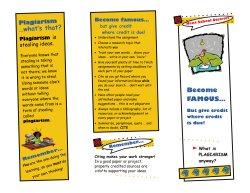
PLAGIARISM AND HOW TO AVOID IT Ben Clift
PLAGIARISM AND HOW TO AVOID IT Ben Clift Department of Politics and International Studies b.m.clift@warwick.ac.uk Acknowledgements This presentation draws on a lecture given by Dr Ben Rosamond in this department last year, entitled ‘plagiarism and how to avoid it’ (Rosamond 2004), and ‘Avoiding Plagiarism’, Purdue University online Writing Lab, Copyright ©1995-2004 by OWL at Purdue University and Purdue University. Source:http://owl.english.purdue.edu/handouts/research/r_plagiar.html This session What is plagiarism? Why is plagiarism a bad thing? What happens to plagiarists? Can you spot plagiarism? How can plagiarism be avoided? What is plagiarism? 2005-2006 MA/Diploma handbook, p.35-6. What is plagiarism? (continued) 2005-2006 MA/Diploma handbook, p.35-6. See also … • Regulation 11 in the University Calendar. http://www2.warwick.ac.uk/insite/info/gov/calendar/se ction2/regulations/cheating/ Regulations Governing the Procedure to be Adopted in the Event of Suspected Cheating in a University Test Why is plagiarism a bad thing? 1. Because it infringes academic ethics and academic norms 2. Because it is a form of theft and a type of fraud 3. Because plagiarists ultimately cheat themselves 4. Because plagiarists cheat their fellow students 5. Because plagiarism reflects incompetence What happens to plagiarists? Procedures 1. You sign a written declaration about plagiarism for every piece of work you submit in PAIS 2, Markers are skilled at picking up plagiarism and we have powerful software available to help us 3. If markers suspect plagiarism, they notify the chair of PAIS and supply evidence 4. The accused is invited to respond to the charge 5. If found guilty, the piece of work in question is graded ZERO 6. Consequences for your overall grade the module in question – mean consequences for your degree 7. Rights of appeal – investigation at the University level 8. Possible disciplinary action by the University Can you spot plagiarism? Consider the following extract … At the beginning, at any rate, the idea of sovereignty was the idea that there is a final and absolute political authority in the political community; and everything that needs to be added to complete the definition is added if this statement is continued in the following words: “and no final and absolute authority exists elsewhere”. F.H Hinsley Sovereignty (second edition), Cambridge: Cambridge University Press, 1986, pp.25-6 WHICH OF THE FOLLOWING FIVE CASES IS/ARE PLAGIARISM? 1 2 3 4 5 So how can plagiarism be avoided? A prior question … Why do students plagiarise? 4 commonly cited reasons 1. The pressures of workload 2. Pressures to succeed The importance of developing time management skills 3. Poor understanding of the nature of plagiarism confusion ‘cultural’ factors respect for seniority What goes on in other walks of life The importance of research skills, note-taking skills and good citation technique 4. Because its easy! Avoiding Plagiarism Through Good Scholarly Practice…. Making Sure You Are Safe … When quoting directly • Keep the person’s name near the quote in your notes, and in your paper • Select those direct quotes that make the most impact in your paper -- too many direct quotes may lessen your credibility and interfere with your style • Mention the person’s name either at the beginning of the quote, in the middle, or at the end • Put quotation marks around the text that you are quoting • Indicate added phrases in brackets ([ ]) and omitted text with ellipses (. . .) • Ensure you note exact page numbers in the reference Source: http://owl.english.purdue.edu/handouts/research/r_plagiar.html When quoting indirectly • Keep the person’s name near the text in your notes, and in your paper • Rewrite the key ideas using different words and sentence structures than the original text • Mention the person’s name either at the beginning of the information, or in the middle, or at that end • Double check to make sure that your words and sentence structures are different than the original text • Ensure you note exact page numbers in the reference Source: http://owl.english.purdue.edu/handouts/research/r_plagiar.html When paraphrasing and summarizing Action during the writing process • First, write your paraphrase and summary without looking at the original text, so you rely only on your memory. • Next, check your version with the original for content, accuracy, and mistakenly borrowed phrases Appearance on the finished product • Begin your summary with a statement giving credit to the source: According to Jonathan Kozol, ... • Put any unique words or phrases that you cannot change, or do not want to change, in quotation marks: ... "savage inequalities" exist throughout our educational system (Kozol 1992: 1). • Ensure you note exact page numbers in the reference Source: http://owl.english.purdue.edu/handouts/research/r_plagiar.html When researching and note-taking Action during the writing process • Mark everything that is someone else’s words with a big Q (for quote) or with big quotation marks • Indicate in your notes which ideas are taken from sources (S) and which are your own insights (ME) • Record all of the relevant documentation information in your notes • Ensure you note exact page numbers in the reference Source: http://owl.english.purdue.edu/handouts/research/r_plagiar.html A few tips: Good Scholarly Practice • Avoid copying when you take notes; use your own words/ideas •When taking notes, make sure you write down the full reference of the source, INCLUDING PAGE NUMBERS • Keep track of citations, full references, page numbers, quotations • Write first drafts without notes • When in doubt CITE! • Take advice Some Useful Links about Plagiarism http://owl.english.purdue.edu/handouts/research/r_ plagiar.html http://www.virtualsalt.com/antiplag.htm http://www.psa.ac.uk/psanews/0403/plagiarism.htm http://www.hamilton.edu/academics/resource/wc/us ingsources.html?CFID=1415438&CFTOKEN=46 586906
© Copyright 2025
















